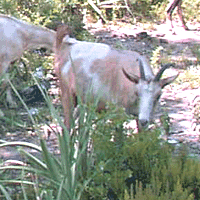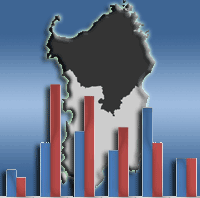
Wildfires in Algeria: problems and challenges
iForest - Biogeosciences and Forestry, Volume 8, Issue 6, Pages 818-826 (2015)
doi: https://doi.org/10.3832/ifor1279-007
Published: Mar 25, 2015 - Copyright © 2015 SISEF
Research Articles
Abstract
In the scenario of the Mediterranean area, where about 54 000 fires and 0.4 million hectares of forest are burned and annually registered (2006-2010), the rank for Algeria is non-negligible with 4.11 million hectares of forest. The annual number of fires and the size of area burned depict a critical situation, which became rather dramatic in 2012. Climate change projections and the estimated changes to wildfire risk for the future decades (2030-2060) indicate that the entire Maghreb region, including Algeria, will be among the most affected areas of the Mediterranean. Longer fire seasons will be experienced and extended by an additional month with each passing year. Despite Algeria’s recent investments in technical means for controlling forest fires, the current suppression-oriented model seems unable to cope with such a phenomenon. Furthermore, the model is unfit in view of the approaching scenario, when fire-exclusion policies need to be complemented with fuel-reduction techniques and fire prevention management. This study aims to establish an understanding of the context and public policy issues related to wildfire management in Algeria. Data were collected by distributing questionnaires to foresters with the objective of identifying obstacles and constraints hindering the efficacy of pro-active measures. Analysis of the data gathered indicates that Algerian foresters are well aware of the importance of prevention, contrasting with current governmental policies that are predominantly oriented towards improving the technical extinction apparatus. A SWOT analysis suggests possible strategic options for improving the efficiency of wildfire control by building on strengths, eliminating weaknesses, exploiting opportunities, and mitigating threats. The results of this study may be adapted to other countries with similar problems as those of Algeria.
Keywords
Algeria, Forest Fires, MENA, Prevention Policy, SWOT Analysis
Authors’ Info
Authors’ address
Department of Agricultural Sciences, University Mouloud Mammeri, Box 17 RP, 15000 Tizi Ouzou (Algeria)
Corresponding author
Paper Info
Citation
Meddour-Sahar O (2015). Wildfires in Algeria: problems and challenges. iForest 8: 818-826. - doi: 10.3832/ifor1279-007
Academic Editor
Davide Ascoli
Paper history
Received: Mar 04, 2014
Accepted: Dec 10, 2014
First online: Mar 25, 2015
Publication Date: Dec 01, 2015
Publication Time: 3.50 months
Copyright Information
© SISEF - The Italian Society of Silviculture and Forest Ecology 2015
Open Access
This article is distributed under the terms of the Creative Commons Attribution-Non Commercial 4.0 International (https://creativecommons.org/licenses/by-nc/4.0/), which permits unrestricted use, distribution, and reproduction in any medium, provided you give appropriate credit to the original author(s) and the source, provide a link to the Creative Commons license, and indicate if changes were made.
Web Metrics
Breakdown by View Type
Article Usage
Total Article Views: 59995
(from publication date up to now)
Breakdown by View Type
HTML Page Views: 48077
Abstract Page Views: 4310
PDF Downloads: 5775
Citation/Reference Downloads: 23
XML Downloads: 1810
Web Metrics
Days since publication: 3933
Overall contacts: 59995
Avg. contacts per week: 106.78
Citation Metrics
Article Citations
Article citations are based on data periodically collected from the Clarivate Web of Science web site
(last update: Mar 2025)
Total number of cites (since 2015): 19
Average cites per year: 1.73
Publication Metrics
by Dimensions ©
Articles citing this article
List of the papers citing this article based on CrossRef Cited-by.
References
Analysis of wildfire risk management from a territorial policies perspective: strengths and weaknesses in the European framework. In: Proceedings of the “3rd International Symposium on Fire Economics, Planning, and Policy: Common Problems and Approaches” (González Cabán ed). Albany (California) November 2009. Gen. Tech. Rep. PSW-GTR-227, Pacific Southwest Research Station, USDA Forest Service, Albany, CA, USA, pp. 261-272.
Online | Gscholar
Forest and land management options to prevent unwanted forest fires. In: “Trees, Forested Landscapes and Grazing Animals. A European Perspective on Woodlands and Grazed Treescapes” (Rotheram JD ed). Routledge, New York, USA, pp. 180-188.
Gscholar
Prevenção de Incêndios Florestais: Um estudo sobre a formação dos técnicos florestais [Forest Fires prevention: a study on the training of forestry technicians]. Trabalho de Investigação tutelado do doutoramento inter-universitário em Educação Ambiental, Universidade de Santiago de Compostela, Spain, pp. 111. [in Spanish]
Gscholar
Forest fire prevention: a study about the forest technician’s training. In: Proceedings of the “5th International Conference on Forest Fire Research” (Viegas DX ed). Figueira da Foz (Portugal), 27-30 November 2006, pp. 13. [CD Rom]
Gscholar
What are the opinions of foresters in Portugal regarding fire? Results of a questionnaire. In: Proceedings of the “2nd International Conference on Prevention Strategies of Fire in Southern Europe”. Barcelona (Spain), 9-11 May 2005. CTFC/COSE/USSE, Barcelona, Spain, pp. 5.
Online | Gscholar
Des incendies de forêts dans la région des Maures et de l’Esterel (Provence). Leurs causes. Leur histoire. Moyens d’y remédier [Forest fires in the Maures and Esterel area (Provence). Their causes, their history. ways to address them] (2nd edn). Librairie Agricole, Société Forestière des Maures, Paris, France, pp. 140. [in French]
Online | Gscholar
Computer aided SWOT analysis applied to SMES using concentrated energies technologies. In: Proceedings of the “International Conference on Manufacturing Science and Education - MSE 2011”. Lucian Blaga University of Sibiu, LBUS (Romania) 2-5 jun 2011. Sibiu, Romania, pp. 213-216.
Online | Gscholar
Analyse spatiale de la régénération forestière post-incendie de la forêt de Fergoug à Mascara, Algérie [Spatial analysis of post-fire regeneration in the forest of Fergoug in Mascara, Algeria]. Bois et Forêts des Tropiques 65 (307): 23-31. [in French]
Online | Gscholar
Assessment of the growing importance of wildland-urban interfaces in fire risk management: wui regional patterns in Spain. In: Proceedings of the “3rd International Symposium on Fire Economics, Planning, and Policy: Common Problems and Approaches” (González Cabán A ed). Albany, California, November 2009. Gen. Tech. Rep. PSW-GTR-227, Pacific Southwest Research Station, USDA Forest Service, Albany, CA, USA, pp. 238-248.
Online | Gscholar
A comparative assessment of the European forest policies and their influence in wildfire management. In: Proceedings of the “3rd International Symposium on Fire Economics, Planning, and Policy: Common Problems and Approaches” (González Cabán A ed). Albany (CA, USA), Nov 2009. Gen. Tech. Rep. PSW-GTR-227, Pacific Southwest Research Station, USDA Forest Service, Albany, CA, USA, pp. 273-282.
Online | Gscholar
Etude du risque incendie à l’aide de la géomatique: cas de la forêt de Nesmoth (Algérie) [Study of fire risk by geomatics: the case of the Nesmoth forest (Algeria)]. Mediterranea Serie de Estudios Biológicos, Época II 20: 10-38. [in French]
Online | Gscholar
L’effet du feu sur la composition des pinèdes de Pinus halepensis Mill. dans le Nord de la forêt de Bou-Taleb, Algérie [Fire effects on the composition of Pinus halepensis communities in the North of Bou-Taleb forest, Algeria]. Ecologia Mediterranea 32: 5-13. [in French]
Online | Gscholar
Les feux de forêt en Algérie: analyse du risque, étude des causes, évaluation du dispositif de défense et des politiques de gestion [Forest fires in Algeria: risk analysis, study of the causes, evaluation of defence apparatus and management policies]. Thèse de Doctorat en Sciences Agronomiques, Université Mouloud Mammeri, Tizi Ouzou, Algeria, pp. 256. [in French]
Online | Gscholar
Wildfire management policies in Algeria: present and future needs, public policies. In: Proceedings of the “4th International Symposium on Fire Economics, Planning and Policy: Climate Change and Wildfires” (González-Cabán A ed). Albany (CA) Nov 2012. Gen. Tech. Rep. PSW-GTR-245, Pacific Southwest Research Station, USDA Forest Service, Albany, CA, USA, pp. 245-382.
Online | Gscholar
Sensibilité de la végétation forestière aux incendies: cas de la forêt domaniale de Chettabah - Ain Smara - Constantine [Forest vegetation fire- sensitivity : the case of the forest of Chettabah - Ain Smara - Constantine]. Mémoire de Magistère en Ecologie et Environnement, Université de Constantine, Constantine, Algeria, pp. 106. [in French]
Online | Gscholar
Improving fire management success through fire behavior specialists. In: “Towards Integrated Fire Management-Outcomes of the European Project Fire Paradox”. (Silva JS, Rego F, Fernandes P, Rigolot E eds). Research Report 23, European Forest Institute, Joensuu, Finland, pp. 105-119.
Online | Gscholar
An overview of policies and practices related to fire ignitions at the European Union level. In: “Towards Integrated Fire Management-Outcomes of the European Project Fire Paradox”. (Silva JS, Rego F, Fernandes P, Rigolot E eds). European Forest Institute, Joensuu, Finland, Research Report 23, pp. 35-46.
Online | Gscholar
Perceptions of forest experts on climate change and fire management in European Mediterranean forests. iForest 7: 33-41.
CrossRef | Gscholar
EU-FIRESMART: Forest and land management options to prevent unwanted forest fires. In: Proceedings of the “Wildfire 2011. The 5th International Wildland Fire Conference”. Sun City (South Africa) 9-13 May 2011, pp. 1-11.
Online | Gscholar
Introducing the Fire Paradox. In: “Towards Integrated Fire Management-Outcomes of the European Project Fire Paradox”. (Silva JS, Rego F, Fernandes P, Rigolot E eds). Research Report 23, European Forest Institute, Joensuu, Finland, pp. 2-6.
Online | Gscholar
Solving the Fire Paradox. Regulating the wildfire problems by the wise use of fire. In: “Towards Integrated Fire Management-Outcomes of the European Project Fire Paradox”. (Silva JS, Rego F, Fernandes P, Rigolot E eds). Research Report 23, European Forest Institute, Joensuu, Finland, pp. 219-228.
Online | Gscholar
La defensa contra incendios forestales. Fundamentos y experiencias [Wildfires defence: fundamentals and experiences]. McGraw-Hill/Interamericana de España S.A.U., Madrid, Spain, pp. 1281. [in Spanish]
Gscholar
A framework for assessing vulnerability of forest-based communities to climate change. Information report NOR-X-414, Natural Resources Canada, Canadian Forest Service Northern Forestry Centre, Edmonton, Alberta, Canada, pp. 51.
Online | Gscholar
The agro-forestry farms’ socioeconomic characterization for a forest fire prevention and management model. In: Proceedings of the “3rd WSEAS International Conference on Climate Changes, Global Warming, Biological Problems” (Panagopoulos T ed). University of Algarve, Faro (Portugal) 3-5 nov 2010. WSEAS Press, Faro, Portugal, pp. 57-63.
Online | Gscholar
Los incendios forestales y las actitudes de la poblacion de las comarcas afectadas [Wildfires and the attitudes of the populations of the affected regions]. Servicio de Estudios e Informes del IARA, Sevilla, Spain, pp. 99. [in Spanish]
Gscholar

















